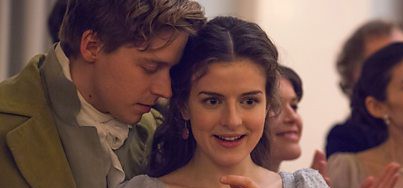
05/02/2016, by CLAS
Exclusive interview with ‘War and Peace’ actress Aisling Loftus
This week Nicola Pearson, a postgraduate in CLAS, caught up with Aisling Loftus, a Nottingham-born actress who is currently starring as Sonya in the BBC’s adaptation of Tolstoy’s ‘War and Peace’. You might also recognise her as Agnes Towler from the series ‘Mr Selfridge’. Here Aisling talks about filming in St Catherine’s Palace, discovering Russian history and her surprise at how much she loved reading Tolstoy!
What was it like reading ‘War and Peace’? Do you have any advice for students approaching Tolstoy for the first time?
I guess I’m glad I had to read it, or else I probably wouldn’t have. I knew it was very long and thought it would be pretty difficult, maybe boring. I can honestly say I really enjoyed it. I presumed that I wouldn’t recognise any of the characters, thinking that an old Russian man from the mid 1800’s would have no insight into me or any of my neuroses. That was the most surprising thing, the fact that Tolstoy is able to get inside all of these different characters and show them for all their complexities and contradictions. He’s unapologetic in exposing his characters – there isn’t really anyone who isn’t criticised or mocked. If you like watching series television, the book repays you in the same way as you get to know, love or hate these people.
How did you prepare to play the role of Sonya?
I went through the novel after reading it and wrote down every reference to Sonya. Then I compared her time-line in the novel with her timeline in the scripts. It’s only a six episode series, so of course there is plenty of brilliant stuff that isn’t in there. For example, Vera, the eldest Rostov, has been cut. The entire cast met for a day with Professor Orlando Figes who has written extensively about Russian history. He spoke to us about societal structure and the way that privileged Russians, such as the characters we were playing, would have behaved at the time. We also learned about the expectations and pressures put on each individual household to host and spend, and some of the implied judgements Tolstoy was making in the novel. For example, if a character speaks French, this is probably an indication we should distrust them or that they’re foolish. After that, we met in our ‘families’, to talk about how each one worked, and how it was to be within that family for each of us. It was really helpful to have that all established before we got out to film, as there isn’t often a lot of time to rehearse, never mind discuss the backstory.
Where did you go in Russia when you were filming?
We spent the first few weeks in Russia and then returned five months later for a final week – most of what was shot in Russia needed snow. The most famous place we got to film in was St Catherine’s Palace, which was incredible as the ball room walls were completely covered in gold leaf. There are lots of beautifully maintained buildings in St Petersburg, but I’m embarrassed to say I can’t remember the names of them! The Rostov’s Otradnoe home was a couple of hours outside of St Petersburg, and this was a bit more Russian as opposed to European in style. Lithuania was our Moscow, and most of the interiors were done there, as well as the battle scenes.
Did you pick up any Russian phrases while you were there?
The camera, makeup and costume departments were all English or Lithuanian and there were only a few Russian crew members when we were filming. My Russian is therefore limited to yes, no, thank you and sorry. I know that’s really poor!
Finally, as you’re a Nottingham girl, what’s your favourite thing about the city?
Broadway cinema, Jam Cafe, Homemade and the Television Workshop on Stoney Street, that’s my spiritual home.
Interview by Nicola Pearson, postgraduate student in French and Francophone Studies
No comments yet, fill out a comment to be the first

Leave a Reply